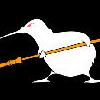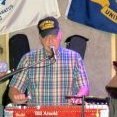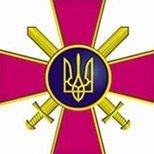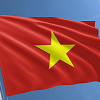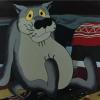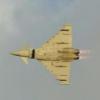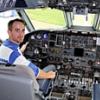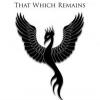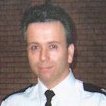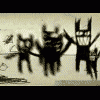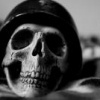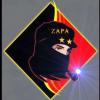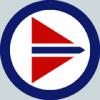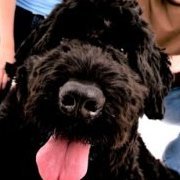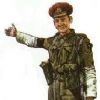Leaderboard
Popular Content
Showing content with the highest reputation on 04/04/17 in all areas
-
Completed within 45 days for a challenge on the Scale Modelers Critique Group on Facebook to start and finish a model in 45 days. Revell kit with Aires seats, Master pitot, Xtradecal decals for main insignia and also all of the stencils, Airscale cockpit decals, Archer Rivets, CMK Flaps and missiles & launchers from spares. Quite a few extra additions were hand made as well. Painted with Tamiya, Mr Hobby and MRP paints. Enjoyable kit, went together very nicely for the price. I'd of liked more surface detail on the lower sides though. It was interesting building to a deadline so tight, not something I've ever done before but there are some areas that I could of added a lot more little detail that had to be left.25 points
-
All done The Eduard Spitfires are probably my favourite 1/48 scale prop kit. This is the third one I've built and all have been enjoyable builds. This one took less than 4 weeks to complete, in hours I estimate less than 20 hours all up. That said, there are few little things that I don' like, those being the two piece cowl, exhaust assembly and sloppy fit of the undercarriage. The cowl is easy to rectify and I'm looking at aftermarket exhausts for the next one. The Aussie MK VIII's have a heap of interesting marking options so I will definitely be building more in the future. This aircraft was flown by the RAAF's lead ace GPCAPT Clive Caldwell, the CO of No. 80 Wing, Morotai, March, 1945. More images and details at my blog20 points
-
Aye, more from me. Both unfinished holdovers from Telford 2016, just needed decals and minor work to finish off. First up, post war Spitfire FR16 with the Photograhic Development Unit. Base Heller kit but with a Hasegawa prop for speed (it'll get replaced as I wanted one with a PRU Blue spinner), resin post war exhausts and 3 spoke wheels robbed from the Sword mk XIVe. And a 607 Sqn RAuxAF Spitfire F16e with four cannon. Airfix mk IXc but with the 3D upgrade set, giving wing gun blisters, post war exhausts and pointed rudder. Somewhere along the line, the intended prop disappeared, so a standard Airfix IX prop was used instead. 3 spoke wheels from the Airfix PR19. Photos: Rob Sullivan19 points
-
This is my second build of this great kit. The new tool Be21c falls together and is a joy to build. The model was painted in MM enamels and rigged with .005 Ethicon surgical stainless steel wire. All markings are from the kit and reacted so-so with MicroScale setting solutions. This is model #14 for the year. I need a break, however I am expecting the new Airfix Hurricane1 and the Percival Provost in today's mail. I hope you enjoy my latest.17 points
-
Been in a bit of a modeling funk recently - finding it hard to build up any enthusiasm for the hobby. Two weekends ago, my wife and daughter were out of town, so I thought I'd give the new Airfix JP a go - a nice, simple build, no complications, just the thing to get the modeling juices going. As I was looking at the boxes in my stash, I thought to myself that perhaps I could build the Airfix Vampire as well, while I was at it - similar, simple colour scheme, so I could airbrush both at the same time. While I was contemplating that idea, I spied the Airfix Gnat box - same scheme...... So I started all three.... And they are nice, simple builds - aside from a few minor issues, they built up very easily and quickly, such that I had all three airframes complete before the end of the weekend - just what the doctor ordered! Finishing them was another matter - the Airfix JP Dayglo decals are thick, brittle and unresponsive to decal softeners. A re-think and a quick look through the old SAM magazine pile showed that I could do the JP in an identical colour scheme to the other two. A profile in SAM showed that I could even build the exact same airframe - XM413 - in an earlier scheme than that offered in the Airfix box, so I could use those decals for this build - bonus! And a lucky bonus too - I discovered I was reading the Airfix painting guide incorrectly - I thought the Airfix box scheme was High Speed SIlver with Dayglo stripes, whereas it's actually LAG - I had painted the model in the wrong colour. Finding the same airframe in the earlier HSS/Fluorescent Orange scheme was fortuitous, saving a re-paint. I even had some spare CFS rhomboid decals in the spares box from the old Matchbox Provost kit. I spent most weeknights this past week adding decals, and just finished all three this morinng. So, here are the Airfix 1/72 Jet Provost T.3, Gnat T.1 and Vampire T.11: Thanks for looking!17 points
-
Finland did use whatever she could put her hands on to fight the USSR invaders. France did sell some Morane 406, and the talent of the Finnish pilots did the rest! Here is the Special Hobby in the markings of M Sgt U. Lethovaara when flying with 2/LLv 28 in Viitana in December 41. Best regards.15 points
-
Hiya Folks, I`m on a bit of a roll at the moment and here is a Hurricane which I have wanted to depict for some time, HL791 `Uncle Joseph' from 135 Sqn flown by Kiwi Pilot Officer `Hugh' Dean RNZAF in the defence of India and in support of the Arakan offensive. A handful of Hurricane and Mohawk squadrons helped to hold the fort in this theatre until more units and more advanced equipment could be spared and I have always been fascinated by these units and the men who were part of them. This is my small homage to them and men like Pilot Officer Dean who was killed in action on the 31st May 1943 when six Hurricanes were sent up to intercept 16 Japanese aircraft over the Allied lines in the Arakan. During May Dean had already flown 31 operational sorties during 50 operational flying hours (not including transit flights to forward airstrips nearer to the Arakan front) and he had led A Flight on many occasions, During one of these sorties he had single handedly taken on 12 Japanese bombers. Like many of the pilots defending the Army on the ground Dean must have been exhausted and it is thought that he was bounced by enemy fighters above him which he had not seen. The wreck of his Hurricane was found in the Burmese hills and he was buried alongside it. Now I`m no lover of `Uncle Joe' Stalin or the Communist`s, far from it as the man was probably an even worse evil tyrant than Hitler,..... but he was portrayed by British wartime propaganda as an ally and many RAF aircraft were adorned wth similar slogans. As usual the model was brush painted and the decals came from a Montex mask set, with the roundels etc coming from the spares box as I`m not brave enough to use the masks when brush painting!! Cheers Tony14 points
-
Actually, three. Firstly, my favourite of the trio, a Blenheim I courier, on the Gibraltar-Malta run. Base kit, but with the turret removed and a load of filler inserted. Next, a Blenheim If, used for attacking Italian ports by night post Tarranto raid, saying "We know where you are and can get you at any time." Base kit but with the addition of a set of resin sand filters. Really, given the middle east setting, the courier should have got them too. Finally, a Blenheim If in a nightfighter/intruder scheme with 54 OTU. Basically, I just wanted to see what a Blenheim would look like in a non-Night scheme. Not too pleased with it but it's not that bad and I think I'll live with it. Photos: Rob Sullivan13 points
-
Hi guys! This is my latest model. I used Eduard interior and exterior sets and Montex masks, so no decals on it. Awarded the gold medal in its category in 29th Athens Greece IPMS Show/Contest. Thanks for looking! http://i237.photobucket.com/albums/ff310/jogiav/Ki-44%2032nd/Ki-44finished-29.jpg[/img] http://i237.photobucket.com/albums/ff310/jogiav/Ki-44%2032nd/Ki-44finished-31.jpg[/img]11 points
-
Cheer !!! Bonus image a telecharger gratuitement Thanks for watch and have nice day !11 points
-
Hi, everybody. On my simple point of view, "Tupolev" - Tu-154 is the most sexy civil aircraft. I like it most of all. The model produced by "Zvezda" is cool. I just made from scratch some small parts. The decal is by "Ascencio" (it is also perfect). That's it.10 points
-
The Martin B-10 was a revolutionary advance in bomber design when it was offered to the United States Army Air Corps in 1932. Its first active service use by the Army Air Corps, however, was quite pacific: carrying air mail for the Post Office. Shortly after the Army Air Corps began operating the biplane Keystone bomber in quantity, its procurement planners started casting about for a more modern bomber. Beginning in 1929, various aircraft manufacturers offered their new bomber designs to the Army. Ford produced a militarized version of its well-regarded Trimotor transport. Fokker and Douglas put forward bomber variants of machines originally intended as twin-engined heavy observation planes. Boeing proffered a twin-engined development of its famous all-metal Monomail transport, with a slim, semi-monocoque fuselage and retracting landing gear, which became a favorite of the aviation press, who dubbed it 'The Death Angel'. The Martin company initially proposed a twin-engine biplane, which was rejected out of hand. Martin then came back with a twin-engined monoplane, albeit one with fixed landing gear and uncowled engines, which was obviously inferior to Boeing's design, and was rejected accordingly. The Martin company returned once more to the drawing boards and emerged with the Model 123 (pictured above). This was a vast improvement. Its motors were enclosed in cowlings, its landing gear retracted, and the Martin design went Boeing's one better with a deep fuselage providing capacious internal stowage for its bomb load. This gave Martin's offering a decisive edge in speed over the Boeing prototype, which carried its bombs slung below the center sections of its wing. There were problems with handling the Martin, however, and at a speed of nearly 200 mph, open cockpits presented problems of crew efficiency. This was partially addressed in the XB-10 prototype, which enclosed the gun position at the nose. Eventually, the wing-span was increased to 70 feet, 6 inches, which improved flying characteristics, and both the pilot's and navigator's cockpits were fully enclosed. With more powerful motors than the prototype's into the bargan, the machine could now achieve a speed of 207 miles per hour in level flight at 6,000 feet. In this form, the Martin design was designated the YB-10, and the company given a developmental contract for 14 examples. Delivery of Martin's new 'Air Power Wonder' (as a leading officer of the Army Air Corps described it) began in November, 1933, when the first YB-10 was accepted by the Materials Division at Wright Field. The purpled style of the times is infectious, when one reads a good deal of it, and some of it survives into present day descriptions of the Martin bomber. It is generally described still as 'all metal', though in fact the rear third of the wings was fabric covered. A metal structure covered with fabric was not uncommon at the time, and such a design was often then described as 'all metal' as opposed to wooden, or mixed wood and metal, but the machine was hardly 'all metal' in the sense of commercial transports like the roughly contemporaneous Douglas DC-1 or Lockheed Electra or Boeing 247. These all employed aluminum stress-skin construction for all structural elements. While some of the Martin's covering employed this technique, some was old-fashioned corrugate sheet. The gun position in the Martin's nose is generally called a turret, but enclosed gun ring would be closer to the mark, for the gun was still traversed and elevated manually, rather than by hydraulic or electric power. Nor, for that matter, is it clear whether the quoted maximum speeds were achieved with a weight of bombs or not. Still, gilded though the lilly was, it remained an extraordinary advance in applied technology for military purposes in its time. Probably more than any other single aircraft, Martin's speedy bomber gave life and legs to the doctrine that 'the bomber will always get through' which would dominate Army Air Corps theorizing throughout the decade before World War Two. While newly arrived YB-10s were being put through their paces in the skies of Ohio, in Washington D.C. a long simmering scandal concerning allocation of contracts for transporting air mail was coming to a boil. What bubbled up out of public hearings in the Senate during January of 1934 would come to scald the Army Air Corps badly. ('Liberty' DeHaviland DH-4b mail plane conversion operated by the Post Office circa 1920) Transport of mail by air in the United States had begun as a wholly government service, flown first by Army Air Service personnel and equipment between Washington D.C. and New York, and then expanded nationwide by a fleet of aeroplanes operated by the Post Office itself. During the Coolidge administration, the Post Office air fleet was sold off, and contracts for transport of air mail offered to private firms. The intent was to foster development of commercial aviation, and the aviation industry in general. The rates paid the companies were based on weight and distance, and were much in excess of what was charged for air mail postage. The system conduced to a good deal of sharp practice by the contractors, who found various ways to game the rates --- in one widely reported instance, an air mail contractor sent out a mass of Christmas cards by air mail, which it carried itself, and was paid twice what it had put up for postage to do so. The system spawned many small companies wholly dependent on the subsidized rates, without ability or desire to expand further into carriage of passengers and freight. President Hoover's Postmaster General in 1929 pushed through a complete revision of the system, which had some odd features on its face. Chief among these was that contractors would be paid according to the amount of mail they were capable of carrying, whether or not that capacity was actually used for mail. The effect of this was to encourage formation of larger companies, with larger airplanes, which could become quite profitable on passenger service with a steady base of Post Office subsidy, amounting in some instances to roughly half their revenues. (One of six Swallow 'Commercial' mailplanes operated by Varney Air Lines of Boise, Idaho, in 1926; the company was bought up by United Aircraft and Transport in 1930) The fuse to full-blown scandal was lit when a small air service owner complained to a newspaperman friend that his bid for an air mail contract had been rejected even though it was but a third of the price asked by the large firm which was the winning bidder. While the new system was certainly efficient (postage costs for air mail were cut in half) and served well its intended purpose of fostering commercial aviation (as passenger service expanded greatly and manufacturers bent their efforts to provide new and better aircraft for this market), the initial contracts had been passed out to several holding companies in a private conference between the Postmaster General and airline executives acting in essence as a cartel, and as these favored companies completed the rapid consolidation of large air fleets, driving smaller firms to the wall and snapping them up at fire-sale prices, there was a good deal of raw stock manipulation by insiders reaping spectacular profits. (Douglas M-3 mailplanes of National Air Transport in 1927. The planes were bought at auction when the Post Office liquidated its fleet. NAT was at the time the best capitalized air transport company in the country. It, too, was bought out by United Aircraft and Transport in 1930.) By the time the Senate took up the matter in public hearings, headed by Sen. Hugo Black in January, the 'spoils conference' held by the former Postmaster was notorious, and gaudy details such as the loss of official records, some possibly burnt by the Postmaster's secretary, and instances where trifling investments had made fortunes overnight for men who were in the know about what was going on with the mail, made for an excellent show (which was capped by the use, for last time to date, of the Congressional power of inherent contempt to put a man in jail for refusing to answer questions under oath). Early in February, as the Roosevelt administration cast about for some way to deal with the situation, in which the existing contracts were simply untenable as a political proposition, the Secretary of War suggested that the Army Air Corps could fly the mail. The commander of the Army Air Corps, Gen. Foulois, was accordingly consulted. Just what he said then has not been clearly preserved; there are several different versions, some of them by the General himself at different times. But whatever it was he actually said, his answer was taken as a hearty affirmative by the Roosevelt administration, which announced existing contracts for air mail transportation were rescinded, and that starting February 19th, the U.S. Army Air Corps would handle the job. It was understandable people without a grounding in aviation would believe the Army Air Corps was up to this task. Gen. Foulois was to some extent the victim of his own policy of publicity for the Army Air Corps, intended to gain popular support in budget battles for his command. Events such as the flight of a pursuit squadron from Detroit to Washington D.C., or the transcontinental flight of a squadron of bombers to join in annual manouvers, were boosted to the newspapers as representing everyday capabiities of the Army Air Corps, rather than the 'one-offs' requiring long preparation, and some recovery for the machines afterwards, which they actually were. Army pilots had little experience of the 'airways' system of radio navigation beacons employed by commercial pilots. Army aircraft generally lacked the full suite of instruments fitted to commercial machines, and when these were present, most Army pilots had as yet little training in their proper use. People in the business of aviation expected fiasco if not disaster, and to rub that in, on the final day civil air mail contracts were still in force, Eddie Rickenbacker, America's premier Great War aviator and now a vice-president of Eastern Air Transport, flew the new Douglas DC-1 prototype from Los Angeles to Newark with a load of mail, setting as he did a new transcontinental record. (A Boeing P-12E pursuit single-seater on air mail service on the west coast) Between Valentine's Day, when Gen. Foulois assured Congress all would proceed satisfactorily, and the 19th, when the Army was scheduled to take over the air mail, three Army fliers died in crashes while on familiarization flights over the routes they were to fly. A blizzard greeted the start of the air mail operation, cancelling the intended flagship flight from Newark. Even when weather permitted, much of the Army's equipment simply was unsuited to the task. Pursuit machines employed on feeder flights could not carry mail sacks without severe displacement of their center of gravity, and this afflicted some light observation types as well; several crashes were attributed to the shifting of mail sacks in improvised stowage rendering machines uncontrollable. The old-fashioned Keystone bombers could handle the weight of the mail, but were not much faster overall than a fast train, especially in adverse weather and headwinds. Gen. Foulois added to these difficulties by reserving his most experienced pilots from the mail runs, which were mostly flown by recent trainees with scant experience of either bad weather or night flying on instruments. The newspapers turned on a dime from 'scandalous contracts' to lambasting the 'murder' of young Army pilots, a pivot greased by the tremendous loss of income inflicted on commercial aviation firms by loss of air mail contracts. Army air mail flights were suspended on March 10, after another rash of fatal crashes. Nine days later they reumed, but with a great reduction in number of routes, and in mileage to be flown. In April the YB-10s were assigned to the air mail operation, handling long distance routes from both coasts. They were eminently suited to the task, but even these had some difficulties; on two occasions, pilots bellied them in because they had forgotten they had to lower landing gear --- that task was not yet a familiar one to even experienced Army pilots. Early in May, the Roosevelt administration pulled the plug on the Army's air mail operation, and began turning air mail carriage back to commercial companies. On May 7th, the last day the Army was the sole carrier of air mail, four YB-10s flew from Oakland to Newark with a load of mail, covering more distance than Rickenbacker had in the DC-1 in February, and achieving a higher average ground speed than he had while doing so. This at least ended the air mail fiasco on a higher note for the Air Corps. When new air mail contracts were let, participants in the 'spoils conference' were banned from any share in them, but this restriction was easily evaded by creative restructurings and renamings; there was no discernable difference between the sytem in place from May, 1934 on and what had come to seem so scandalous late in the previous year. About the only real changes were that Gen. Foulois no longer commanded the Army Air Corps, and that Army flight training began to stress flying by instruments and in bad weather. The YB-10s went on to other high publicity flights, including a mass flight of ten to Alaska and back in July of 1934, doing much to restore the reputation of the Army Air Corps. They went then into squadron service at March Field with the 7th Bomber Group. The main production variant would be the B-10B, which Martin began delivering to the Army in 1935. On the B-10B, arrangements for exhausts and air intakes differed from those of the YB-10, but there were no other differences worth noting between them. Later in the design's production run, Pratt and Whitney radials were substituted for the original Curtiss-Wright Cyclones, and this version was designated the B-12. By 1938 Martin's 'Air Power Wonder' was being eased out of first line service in the United States by the Douglas B-18 (a derivative of the DC transport series) and the early marques of the Boeing B-17, with the displaced B-10s consigned to service overseas, in Panama, the Phillipines, and Hawaii. None remained in U.S. service by Pearl Harbor in any but auxiliary roles. When the Army released the type for export in 1936, Martin secured orders from Argentina and Turkey and Siam, and from China and the Netherlands East Indies. An improved version of the type, with a different wing-plan, and a long 'greenhouse' atop the fuselage enclosing both the pilot's and navigator's cockpits, was sold in quantity to the N.E.I. The Chinese Martins were employed against the Japanese in the Sino-Japanese War: two once flew to Japan, where they dropped leaflets instead of bombs. The later model Martins sold to the Netherlands East Indies remained a major element of its air strength when Japan 'turned south', and were expended in combat defending Singapore, and the N.E.I. itself. This model represents the first YB-10 to go into air mail service on the west coast, ceremonially dubbed 'City of Oakland' in a formal christening on April 19, 1934. Though I am not certain, I strongly suspect this machine was the flagship for the final trans-continental mail run on May 8th. All YB-10s were delivered in Olive Drab and Orange Yellow, and while on air mail service were not repainted in accordance with the February directive that fuselages be rendered blue in future, though they were repainted before the Alaska flight. Here is footage of YB-10 'City of Oakland' in flight, and at its christening.... http://mirc.sc.edu/islandora/object/usc%3A12361 (link broken, will try and find it) The kit is the old Williams Brothers 1/72 B-10B offering. It was my eventual choice for the 'Golden Age' group build over in the HyperScale 1/72 forum. This was pitched towards the 'wonders of the future today' spirit marking much of aviation at that time, with aircraft serving in combat, or obviously kitted up in preparation for looming war excluded. We drew a lot of racers and airliners and such in consequence, and in keeping with this focus I chose to do the Martin as an early example on the air mail runs. I hadn't known much about this beyond that it happened, and didn't go too well for the Army, but looking into it found it to be quite a story, and am glad I did. I built the kit pretty much OOB, except for small changes necessary to represent a YB-10 instead of a B-10B (scratch-built air-scoops atop the cowlings, and exhaust venting at the lower rear of the cowlings). I made no attempt to detail the interior, apart from what the kit provides. I thought the kit raked the landing gear legs a bit too far backwards, and putting them at the angle I thought they should have made it necessary to extend the rear braces by about 4mm. The kit piece for the bomb-aiming window got clouded on the inside by primer over-spray (how it happened I am not quite sure, but suspect leaking through a small crack in the join), and so I had to make my own replacement piece. I put in a blanking bulkhead behind the turret. Decals are mostly from the kit, and from an old MicroScale sheet that came with it when I bought it second-hand years ago. That had 'Oakland', but not the smaller 'city of' above it; those I made from dry transfer letters on clear film. Paint is home mixes of various Model Master and old PollyScale acrylics, cut with Future and applied by brush, then given a going over between coats with a 3000 grit and a 5000 grit polishing pad. Army policy at this time was to maintain a polished, even a waxed surface, on aircraft, and these were pretty new, and certainly were well maintained, so I made no particular attempt at weathering or indications of wear. There is always a certain variance when you mix each coat of a color, and apply the paint sparingly and sand it, and that seemed to me enough for this show-horse. In the video linked to above, the machine does not seem to be rigged with a radio array (there is a point where the wing-tip is shown from quite close), so I did not do radio rigging. This kit has a number of good points, and of course that it exists at all is a solid point in its favor --- if you want a kit of this quite significant aircraft in 1/72 scale, this is what is available. Surface detail is nicely done, and fit of major components no particular problem. I liked the socket arrangement for the wing to fuselage joints very much. There are a lot of serious ejector towers, though, some inconveniently located, and a great deal of heavy flash. It can be difficult to tell flash from part at times when doing prep work. I don't know if the recently re-issued kits are better or worse in this regard than the old item I built. The real difficulty is the clear pieces. They simply do not fit, not without a great deal of work, more work than I expect most people would want to put into the matter. The canopies are thicker on the port side than the starboard, which complicates the matter of getting the pieces to fit. It is necessary to bevel the interior mating surfaces a great deal to accommodate the curve of the fuselage, and to put a curve into the mating surfaces of the windscreen portions as well. I found it necssary to cut away some of the fuselage mating surface to get the windscreen portion of the rear canopy to fit. In all instances, pressure was required when actually gluing the pieces in place to get the barely acceptable fit that was managed. The clear pieces were Future dipped to get the insides shiny, then after the canopy mating seams to the fuselage were filled and sanded down, the outside was stripped, then polished with fine grit pads, baking soda, and Novaris polish. They still retain much of their 'Coke-bottle bottom' character even so. I made no attempt to 'blend in' the clam-shell piece at the rear, as I have seen a close-up photograph of this from the right rear, and there was appreciable daylight between its bottom frame and the fuselage top. Framing was put in with painted decal strip, stuck down with Future. The turret is a bit different. A lot of work needs to be done on the fuselage 'mouth' the turret sets back into. Edges have to be thinned, especially at the bottom, and a deeper curve cut in at the top. Otherwise there will be bad gaps. I found it necessary to fill in at the front of the 'ring' with some shim plastic, but that could just have been me. This is the first use I have made of a 'light box' wife got me for Valentine's Day. It came with two little LED spotlights, quite bright, and a little tripod. I am not too comfortable using the latter yet, but the outfit is nice. Now I no longer require flash or sunny days for pictures, and there is accordingly a good deal less stark shadow and glare to deal with, also the color stays better. A note to the eagle-eyed.... Yes, the 'O' in 'Oakland' on the starboard side does not quite match the rest. The 'O' of the first 'Oakland' strip I applied on the port side shattered irretrievably. At this point I was not sure the legend appeared on both sides (I had only seen pictures of the port side), and since the decal sheet omitted 'City of' and called for a blue fuselage I was not inclined to take it as gospel that 'Oakland' was on both sides, just because that was what was on the sheet. So I cut the 'O' off the second 'Oakland' strip on the sheet, slotted it in as replacement, and left it at that, taking the chance that, like a lot of nose art and presentation inscription, it was on the one side only. When the build was nearly done, I was introduced to the film of this machine linked to above, which clearly shows in its opening the marking did appear on both sides. None of my transfer lettering matched the height of the decal letters, and I feared I would have to strip the name from the port side and change the ID number (13 and 15 were photographed clearly as well), but I wanted to keep the name. I found finally a zero that matched pretty close on an old Pegasus RFC serial sheet, in the 1/48th portion. Since looking at the video more closely, I have come to suspect the decal lettering is a little too large, or else the '11' at the nose is a bit small. But that was past correcting, if it is the case, by the point the build had reached, and with the group build deadline coming up. James10 points
-
After many months of searching for info on this one off prototype,i only ever came across two images, from which i have made up a 3 view plan in 1/72 scale,With only the wingspan known ,in order to scratch build this aircraft, to the best of my ability. So here it is finally finished. [/URL] [/URL] [/URL] [/URL] [/URL] [/URL] [/URL] Lastly a couple of period shots! taken from a similar angle to the only known images i could find. [/URL] [/URL] That means i have now completed the P.V.1, P.V.2, P.V.4, P.V.7 and P.V.8, leaving the P.V.2BIS, P.V.5 ,P.V.5A and P.V.9 to go.9 points
-
My thanks to you for that TT. 'Winch, Floor and Loo', that well-known firm of solicitors in Hastings: "Have you had an accident at work which wasn't your fault? Did you drop the Corona capsule into the sea? Or perhaps you fell out of the back of the aircraft into the ocean yourself? Either way, we're here to help...." Taking the advice of the Martian Consul to Poole I gave the radio problem a rest for a bit and went browsing for a few other jobs of interest. Daft as it sounds I've only belatedly realized that it can be much more fun to go looking for bits to do that appeal to you in the moment, rather than succumbing to a pressurized ticking-off of boxes one-by-one. Ye probably realized that long ago didn't you? I however is still learnifying this game... So as a bit of a change I went for a browse around the kitchen with a particular aim in mind. Here's what I grabbed: Spatter guard, tea-strainer and fly-screen. This part of the proceedings is actually @71chally's fault in part - who not only has me inspired by his foil work on his Lightnings, but posted this picture of the Box-bog earlier: Image credit: OldAirmail. http://forums.simviation.com/phpBB3/viewtopic.php?f=40&t=173444 Needing to reproduce the textures of that soundproofing material you can see here on the walls, I had a crack at rubbing kitchen foil down on the various meshes I found in the kitchen: The fly-screen on the right is completely out of scale, but the embossing from the spatter guard to the left is pretty useful-looking. A closer look: I deliberately used pre-scrunched foil for this that had been smoothed out again as I was looking for a little random texture across the material aside from the embossing that would give a slightly 'used' feeling. The other person to blame for this detour is @Tomoshenko, on account of the delicious Tomoshenkification he's applied to his Lanc interior with take-away foil. In this case I used a similar 'brass-rubbing' technique as above to develop some surface relief in the foil, but this time for the sections of materials that cover the interior roof of the Boxcar. Using the roof moulding of the kit itself as a template tuned out to be a handy way of getting a variety of weights to lines: Again here I'd started out by using pre-scrunched foil to introduce a varying non-uniform look to the surfaces. What I needed was a series of strips to go horizontally across the fuselage, rather than down the length of it as you see here, so it was simply a matter of rubbing out some lines and rotating the foil through 90°. Here's some panels being worked-up: For the roof I needed concave lines going inwards, rather than protruding out, like so: One thing I needed to keep stopping myself doing when gluing these panels into place was to resist the urge to smooth them down. it's almost a programmed instinct but of course it would erase the lines and textures. Also I want that material to look as if it's sagging down slightly in places under gravity - as it appears to do in reference photos - so the glue CA was blobbed on randomly. Now. With that laid-down and curing, I revisited the cargo bulkhead. I mentioned before I wasn't happy with moulded detailing on the kit, which I feel is somewhat suspect in this region, so I chiselled off the various boxes that had been present, along with the microstrip I'd added earlier, which just looked too exaggarrated: Better. I also found out from a dry-fit that I needed to contour the back of the toilet cubicle in order to follow the curve of the fuselage more closely: Having crept round the the front side of the bulkhead and with the chisel still to hand, it only seemed sensible to remove the Tellytubbies radio sets: I'll leave those two (to my reckoning quite spurious) sets of dials where they are as the navigator/radio-op's bench will thankfully draw a veil across them. The prodigiously-detailed Aerofax volume on the Boxcar handily has a chart of all the various radio configurations of the different variants of this aircraft. Given that the 'J's were predominantly converted 'G's, I think it's probably safe to assume that a lot of the stuff in what I think are these shots of 'G' radio gear will do to build up something convincing: My apologies to the original posters for not crediting - I found these hiding away in my references from some time ago... One thing that was different on the 'J' variant of course was the direction-finding gear to lock-in on the satellite transponder (which accounts for the different array of aerials on the nose of the aircraft), but without any definitive shots of that gear, I'll use these images to construct some representative detail. IIRC the direction-finding gear could be misleading in sometimes indicating that the capsule target was straight ahead, when it was in fact 180° to the rear, causing problems on some missions. The angles in the above shots make it difficult to put a composite together to refer to so I took them into Photoshop for some perspective processing and angling: That's about the best I can pull from these sources in order to get an approximate overlap. Not how the lower right radio set (the one with the angular sweep on the front and the wire draped down over it) appears to be the one Italeri actually moulded under the desk... I bunged the nav's table in place temporarily to give a level, and then had some fun cutting up the rocket rails off a Swordfish (I seem to have an endless number of these items and for the life of me don't know where they keep coming from...) in order to mock up the requisite the radio sections: Messy-looking to begin with but just blocking out shapes here so that I can get get a feeling for scale. Getting there, but a quick appraisal of this and I realized that in fosussing on getting these to the right height, I'd built this section too long horizontally! Lastly, the addition of the embossed foil to the walls of the toilet cubicle: It doesn't look that great in the raw foil state but with a whiff of primer on, the subtelties of texture become more apparent: The trough and decking have come up alright as well under a coat for grey: I'm most definitely pleased however with the effects achieved with the roof area: More by luck than judgement that 's exactly the scale effect I was after. I'll leave it at that now for today. A number of significant problems sorted out. I need to go back to the radios, tidy those up and add some dials and so forth, then I'll vacate the cockpit and have a another stab at winch and pole mounts. Better check the stock of Albion tubing for that. Ta for looking! Tony9 points
-
3rd Party Off Board Targeting would be the rejoinder to that; the problem being that you could - quite legitimately - say 'well, OK. Show me the details'. The problem then becomes that the over-used line 'Er... it's classified' (or 'I could tell you, but then I'd have to kill you') kicks in, a line which is, of course seen - not unfairly - as being nothing more than sitting somewhere between the Mandy Rice-Davies defence and using security to attempt to hide legitimate concerns. In some cases, though, it isn't. The F-35 - and I don't have the Uber Jolly Secret clearance [not the real level of clearance because you need to have a certain level of clearance to know that it exists...] needed to comment, merely the privilege of having a brew with people who once did - may, may be an instance of a programme where transparency, such as it is, permits the flaws in the programme to be highlighted (no harm if the enemy knows about the problems which are probably too big to hide), but not the good stuff. This is exemplified, I think in this: Now that's an informative post. But... The DoD report is, of course, a fairly germane document. The Straus link, though, is problematic - it repeats some of the superficial claims about the F-35 vs F-16D fight and jazzes them up a little. Let's just look at that a moment. So, the narrative is that the F-35 is sent up against and F-16. The latter is fitted with tanks and is a 2-seater, this being a deliberate step to make life easier for the F-35. Now, this is what is commonly referred to by a portmanteau word involving male bovines and excrement. Or involving commentary about the use of tin foil as fashionable headgear. Why in the name of Satan's Trousers would you fix the fight knowing that it was quite probable that information suggesting a fix, or worse, that the supposedly degraded aircraft (flying in what is generally known as 'a fairly common fit for this sort of thing', by the way) still soundly kicked the posterior of your new wunderallesingenalletanzenflugzeug (with apologies to anyone who speaks proper German) six ways to Sunday via a leap year and three bank holidays, thus makes your new toy look, well, frankly a bit rubbish? As is all explained pretty well by someone who has a decent idea of what he's on about - 1000 hrs in ANG F-16s and 4 years as a Hornet pilot in the USNR - here. Yet, scroll down to the comments and you end up with an array of comments from people who, in the main, (NB that caveat) have never read a document with a classification level above 'Unclassified' and whose only experience of sitting in an aeroplane has involved the production of a passport and ROE which include 'do not walk about the aisle when the seat belt light is on'... As happens with the comments under this lot of observations from one of the Norwegian pilots, who was spared the usual 'Oh, it's hopeless/Oh, it's the best aeroplane ever and I want to have its babies' extremes by not having comments under this (scroll down for the translation) Now, Mr Lemoine doesn't have as many hours under his belt as others, but he has, at least, flown the aircraft involved. There are also a couple of snippets in there to ponder. He jokes about the pilot of the F-35 being an F-15E pilot. Yet... remember when the Typhoon was recently in RAF service and handed a couple of F-15Es their tail feathers? The usual 'Typhoon is rubbish' crew - including some now from the 'F-35 is rubbish' crew - were out there saying that well, of course, the Typhoons won, since the opposing pilots were mud movers who dabbled in the sport of kings and thus not likely to show just how good the F-15E is (and how hopeless the Typhoon was...). But that consideration isn't, apparently, relevant now. And what were the parameters of the test? Was the F-35 attacking, or was it defending? What weapons was it allowed to simulate using? Could it simulate using weapons to full capability? And so on, and so on. Also, bear in mind that the test wasn't a 'which is better?' test, but part of the overall test programme. Part of this involved conducting air fighting as part of the examination of the flight control envelope. The report, when examined, demonstrates that rather than 'Oh, dear, we have a problem', the tone was more of 'OK, we need to alter some of the flight control software to allow the aircraft to manoeuvre more aggressively'. The writers of the FCS laws had been fairly conservative, and one of the reasons for this sort of testing is demonstrate that the laws can be a little less strigent - indeed need to be - to allow the aircraft to reach its potential in manoeuvring. The F-35 didn't have a full weapons/sensor suite on board either, so was further hamstrung. We need to move away from the notion that F-35s will be required, on a routine basis, to do WVR 'dog fighting'by itself. The dog fight isn't dead, but look at the stats - how many aircraft has the USAF/USN brought down since 1991? How many of these were destroyed using BVR weapons (AIM-7 or AIM-120) rather than AIM-9? The answer is that BVR weapons - even if the engagement got to WVR - predominate in this. Then, we have to ask when the F-35 is likely to find itself completely unalone - the answer is 'rarely' for the Americans and 'rarely' for the UK since a whole slew of supporting capabilities will be involved - EW, SEAD, F-22s, Typhoons.... Yes, F-35 has 'first night of the war' capability, but look at what 'first night of the war' looks like in a coalition operation, particularly if the US is playing a small part... Your enemy IADS isn't going to be dealing just with F-35s cheekily sneaking in with a couple of internal weapons on board - it's going to have been visited by a mixture of B-2s, TLAMs, F-22s, Storm Shadow, AGM-158 and that's before various aviation writers start wetting themselves when they realise that there's an operational version of RATTLRS which has been quietly minding its own business under 'black' funding before arriving at a SOC/airfield at about Mach 4. Yes, some enemy fighters will get airborne - but in amidst a significant amount of chaos. The F-35 won't have it easy, but the notion that it'll fight its way in, or spend a significant amount of time attempting (and failing) to deal with Su-27 derivatives (or J-10s, J-11s, J-20s and possibly J-31s) on nights one and two of the war is to look at the situation through a straw and to miss the bigger picture. The US does not do faffing about on night one, it does 'apply large hammer' (see Libyan AD system in Op Odyssey Dawn for further details - and that was a half-hearted commitment...). And let's assume that, somehow, the F-35 does find itself getting to the merge with an enemy F-16/J-10 - basing analysis of the ACM potential of an aircraft upon a test airframe which isn't fully developed is, frankly, a bit silly and makes the use of that by authors rushing to damn the F-35 look as though they're repeating stories without bothering to really analyse them as information emerges. Now, none of this involves drinking F-35 Kool Aid or similar. What it involves is accepting that many of the sources which are available swing too far to the opposite side of arc from LM's press releases. All of them are based upon material which is incomplete because of the classified material. It may be - I have no idea - that there's some absolute bombshell being kept under wraps (aircraft can't fly if the temperature is below -5; or the aircraft becomes sentient in certain attitudes because of a slight glitch in the FCS programming and has had to be prevented from using the MADL to order a skinny latte from Tim Horton's; or has a weapons system which has somehow developed teleological ethical reasoning and refuses to release weapons unless the Attorney General personally assures the system that it's OK.) Equally, it may be to the advantage of the partner nations to keep some information under wraps, particularly if its of the sort which renders information gained from the Chinese hacking of the programme system obsolete... The point is that we can argue about this until the F-35 enters service - our information pool is limited and is driven by agendas. Is the F-35 costly? Hell, yes. Does it have developmental problems? Hell, yes. But does this mean that it's a complete disaster, or is it a case of 'game changing capability costs a shedload of cash and has many problems to overcome'? We don't know.... There are people who do, but as they don't really want to be done for breaches of various acts protecting secrecy, they're not going to say, at least not in any depth to rival the comments of the nay-sayers. Beware of bloggers, commentators (David Axe-to-Grind, Pierre 'Didn't Actually Design the F-16' Sprey) and the LM PR department is, I think, my point... As I've fallen into my usual habit and was asked for the acronyms last time I did so... FCS = Flight Control Sofware WVR = Within visual range BVR = Beyond Visual Range EW = Electronic Warfare SEAD = Suppression of Enemy Air Defences IADS = Integrated Air Defence System RATTLRS = Revolutionary Approach To Time Critical Long Range Strike (BGM-178 and possibly AGM-178) SOC = Sector Operations Centre (in an air defence network) TLAM = Tomahawk Land Attack Missile ACM - Air Combat Manoeuvring9 points
-
Morning, "Finished" this one yesterday so thought id do a few pics. The decals in general are quite good, but certain ones ( the ones that are meant to curve round bits) dont fit brilliantly am needed a little touch up afterwards with some paint, hopefully not too noticeable!!! Haven't put atteanas etc on as I've a feeling they would ruin the decals!! One of my favourite schemes from recent years so thought id give it a go, hope you like it: Italeri 1.72 Jaguar GR3 XX119-7 by Jonathan Francis, on Flickr Italeri 1.72 Jaguar GR3 XX119-3 by Jonathan Francis, on Flickr Italeri 1.72 Jaguar GR3 XX119-1 by Jonathan Francis, on Flickr Italeri 1.72 Jaguar GR3 XX119-6 by Jonathan Francis, on Flickr Italeri 1.72 Jaguar GR3 XX119 by Jonathan Francis, on Flickr Thanks for looking Jon8 points
-
Hiya Folks, Yes I know,.....another Harvard,..... this time a Mk.III if the Fleet Air Arm based with the Station Flight at RNAS Hal Far, Malta in the late 1940`s. Here is the photo that started it all off; And here is my rendition in model form; From the photo it appears that the fabric covered control surfaces still wear camouflage finish along wth some of the engine ancillary bay side panels, so they either came from another aircraft and have been refitted to this natural metal aircraft,...or have yet to be doped/painted silver to match the finish of the rest of the aircraft after it has been stripped to bare metal, although judging by the position of the fuselage roundel and the fact that the narrow North American company serial `font' is in situ it would seem that it was in fact delivered in a natural metal scheme. For the silver finish on the model I used rattle can Tamiya Bare Aluminium while everything else was brush painted using Humbrol acrylics which were slightly thinned down to make them easier to apply. After a coat of gloss varnish for the decals, the model was brushed using satin varnish to slightly dull down the sheen. Thanks to my mate Ian Campbell for the artwork which allowed the decals for the 911 codes to be printed and also for providing me with a spare prop and wheel to replace those missing from my kit,......cheers fella! All the best Tony8 points
-
Ok so I decided to build both of my Italeri 1:32 Starfighter kits together as I couldn't decide what schemes to do! In the opted for the following: Italian Air Force F104G 154 Gruppo, 6 Stormo, Ghedi 1971 Marineflieger Geschwade 2, Eggbeck 1973 I thoroughly enjoyed both builds - excellent detail and a good fit except the tail section which was a devils own job to mate with the main fuselage. Both kits we made out of the box with only canopy masks and Eduard cockpit detail as extras. Paints were all Tamiya this time with Alclad for the metal areas. Since I've started mixing Tamiya with Mr Color leveling thinner I have been getting excellent results and for me Tamiya is easier to get hold of locally. Big thank you to 'IanF' who stepped in with a replacement decal for the Italian aircraft as I had made a hash of it! Anyway the photos - will try and get a few more done tomorrow Chris8 points
-
Hello! I started building this kit on March, 2015 and just finished it last January. It is a really good model (lot of details, wonderful surfaces) and the little problems are now solved with the new edition. Swiss colours add a flashy touch on the classic scheme... and my wife is from this nice country , so I decided to paint this Bf 109 this way. Some pictures: If you want more pics of the finished model, follow this link: http://fighters.forumactif.com/t81668-chocolat-fromage-etc-etc-enfin-l-oiseau-en-photos The work in progress thread is here (I'm struggling with the pictures links): I am really happy to share with you my first finished 1/48 kit after a loooong pause with this hobby. Comments and critics are welcome of course! Cheers PZR8 points
-
Evening lovely people of BritModeller. I have managed to eek along nicely and get some painting done and some.... well you'll see. First off after the priming I did a dark pre shade and a quick blast of the boxes. then being stubborn and going to the LMS and picking up XF67 I sprayed everything a shade of Kermit. I added some yellow green XF 4 to lighten and added some highlights. I'm happy with that. I left that to dry and did this. What on earth!!! i had to let that dry so I brush painted the black detail on the tub in a more crisp fashion. that'll be left now and I'll paint the details tomorrow. Now on with the mystery item. I've decided to test out my four shades of silver on a Mule. (An unused Part from my seafire build) I'm using Vallejo metal colour as it's acrylic and I've had good results in the past, although I have only lightly sprayed it and have thinned with Tamiya thinners. Apparently you don't need to thin it so I'm going for a test run. I have Dull aluminium. Duraluminium. Chrome and steel. I have labelled the sections A B C D you can just see the letters albeit in backwards order on the lower parts of the wing. They all look great and I'm struggling to take a worthy shot but it's not possible. I'll pop a pot in the shot so you can see the shiny. this is A (dull aluminium) and B (steel) and C (Duraluminium) D (Chrome) I have sprayed a thick coat without thinner and found that it goes on really well especially the dull aluminium it's really, really nice to look at.. I think I'll use all apart from steel as I want some panel variation. I need to try some post shading using Tamiya smoke. Another new for me. any hoo, I'm calling it a night. More tomorrow. thanks you for stopping by. All the best and as always. Happy Modelling. Johnny silver man.8 points
-
Tamiyas 1/48 A1H skyraider I used a load of eduard and quickboost sets in this and master model barrels and pitot tube. painted in my usual mix of tamiya, mr hobby and xtraylics, and had my normal nightmare spraying the white, had to strip it and respray. the decals where horrid, very thin, ripped and didnt want to stick, so alot of touchups. thanks for looking7 points
-
I know, I know, but think about the BM posts! Thanks Wooksta - just searched to see if there's a local store but there are so many pound shops I couldn't find it. I did find 'Just 99p' but their website says they're now closed. I'm not surprised - who thought they could survive at those prices! Thanks chaps - I do like the smell of fresh-cut lawns and they do look nice with the stripey bits. Getting someone else to do it sounds tempting though... Hi Phil - glad you found me! Thanks Benedikt - you're right, I shouldn't fret, I'll just get on with it! Steady hand and mojo found: Happy with that (just needs a few blobs of Liquidex) so it will get stuck together soon.7 points
-
I've started the Tamiya 1/350 USS Enterprise in 1/350th scale. Currently working on some of the air-wing and changes to the island structure as it is being backdated to how she was in 1976. Still have to put on the landing gear, gear doors, access steps, engines and pylons. The canopies were tinted and I am plucking up the courage to paint the canopy frame. It's a slow long-term project which I hope to finish by the time the telegram lands on the doorstep.6 points
-
Here you are now. I've evened the surrounding cabinet up and added the various dial-like gubbins from various grades of Slater's microrod: Yeesh. Look at all the plastic dandruff left over from rubbing this on the wet and dry to get it level. It seems to be this season's must-have fabric for the fashion-conscious modellista alright! A last check to make sure scale looks ok: Sufficient unto the day, or at least good enough to bear a searching glance through the cockpit windows later on. Right, Ah'm off to make some foil leggings:6 points
-
Thanks Giorgio I know, cutting the grass only encourages it! Thanks Wooksta - we have a Poundland so I'll have a look next time I'm in there for modelling supplies! Thanks Benedikt - I don't know why I fret about these things, I should just use what I'm happy with! Progress this morning has been pathetic. I glued the boxes to some Plasticard (the backs do show through the canopy, I've just checked the NF, rats) to close them up: Untitled by Ced Bufton, on Flickr they'll get trimmed later. Stuck a few bits and painted even fewer: I'm waiting for a steady hand. And some mojo.6 points
-
Trumpeter 1/48 DH100 Vampire FB. Mk.5 Kit goes together nicely, I know it has accuracy issues, but quite a nice simple build. Used Tamiya acrylics paints. Hope you like it.6 points
-
I think we both know they usually show up with information about the cockpit interior right about when you've finished attaching and rigging the upper wing.6 points
-
As usual I painted myself into a corner, my own fault Nobody said I have to fold the blades, the blinking model is tiny enough, no arguments about that Hubris, that's what's going to do for me they tell me Any road up... Whilst I Clear-ed the tailboom ready for more decalisation and with the Clear Jar open used it to stick the hole filling perspex bit back on after edging it in RAF BG I had a go at tidying up they rotor gear head thingmys The pitch change yoke devices were carved from my favourite JB Productions supersprue and glued down for stormy weather Pitch change rods then attached And checked for irregularities and misplaced dooberries, did you see what I did there? still checking against these close ups and sorting the minor little tiddley bits The blade roots sections will be getting a dose of Mr Dissolved Putty to fair in the big bits to the little bits but I will probably wait until the root plates are ready for the blades Soon chaps A last one just to show you what the close up brings into focus, phew ciao6 points
-
Hiya. Here's my latest project. After few WWII vehicles. I wanted to go for something modern. Few years back I was in Berlin and found a hobby shop. I bought Trumpeter's Grizzly for a bargain price as box was a little damaged. This is an outcome of this. Trumpeter's Canadian AVGP Grizzly. I read few reviews indicating that model is full of mistakes. Maybe it is, but it's fun to build and - in my case - for painting colour modulation training. See for yourself. That's it. As I said, it was great fun to build. Hope you like this. Thanks for watching. Dawid5 points
-
Lots of firsts for me this one. Liked building it, but found it tricky in places and the challenge of paint scheme was good (never done Luftwaffe mottling before). Not the easiest kit but I think this was an earlier AZ model kit, got 2 more 109s that are more recent and they have improved instructions I think. Built as 109G-2 flown by Feldwebel Anton Hafner, 4./JG51, El Aouina, Tunisia, December 1942 First ever 109 kit ! First ever RFI on britmodeller.com Nowhere near as good as some of the efforts I see on here, but I was happy with result First ever attempt at mottling with an airbrush! First ever AZ model kit!5 points
-
Neca figure,approx 7 ins with scratch built base,Been a bit of a chore this one,but reasonably pleased with the end result. On to pastures new....ish Cheers Andy5 points
-
More work on my days off (I'm lucky as my shifts give me 4 days on the spin to work on stuff) RAF Mid-Stone base coat (Hataka Acrylics) Dark Earth camo (Blutac method used for demarcation) Underside sprayed Azure Blue Gloss coated and decalled, with some oil panel lines in. This version had no large fuselage numbers identifying it, just the small serial numbers at the rear.5 points
-
Another night, another update... The tail bracing is finished. One penny is just for those who is unfamiliar with 1/72 Also I started with the wing. I thought it will be too boring. But I managed to make 4 wires. With such a pace I will need 9 evenings to finish all the rigging... And then I will definitely switch to 1/485 points
-
Have been working on four parts for a diorama which will include a Hawker Typhoon, Matador 0854 with Cole Crane Mk V11, a Willys Jeep and a Accumulator, this will be shown with the Typhoon engine hanging from the crane hook, being just replaced with a new one, I hope I can catch the moment. Have bought all the aftermarket stuff I think everyone knows what is out there. First picture is what I want to capture, photo is for reference only. Cleaned up a lot of the seams, filled a few holes etc etc and then painted aluminum Machined the shaft out of brass Started to add some detail to the controls Until next time, Regards Richard4 points
-
"My objective is peace in Europe, I trust this trip is the way to that peace." -- Neville Chamberlain, 22 September 1938 "How horrible, fantastic, incredible it is that we should be digging trenches and trying on gas-masks here because of a quarrel in a far away country between people of whom we know nothing." -- Neville Chamberlain, 27 September 1938 England expected every man that day To show his motives were ambivalent. They played the fool, not to appear as fools In time's long glass. A deprecating air Disarmed, they thought, the jeers of later schools; Yet irony itself is doctrinaire -- Donald Davie, "Remembering the Thirties" "My good friends, for the second time in our history, a British Prime Minister has returned from Germany bringing peace with honour. I believe it is peace for our time." -- Neville Chamberlain, 30 September 1938 "[W]e have sustained a defeat without a war, the consequences of which will travel far with us along our road; they should know that we have passed an awful milestone in our history, when the whole equilibrium of Europe has been deranged, and that the terrible words have for the time being been pronounced against the Western democracies: 'Thou art weighed in the balance and found wanting.' And do not suppose that this is the end. This is only the beginning of the reckoning. This is only the first sip, the first foretaste of a bitter cup which will be proffered to us year by year unless by a supreme recovery of moral health and martial vigour, we arise again and take our stand for freedom as in the olden time." -- Winston Churchill, Hansard, "Policy of His Majesty's Government", 5 October, 1938 20170402_141451 by Edward IX, on Flickr I've struggled all week to think of what I wanted to build next. I have something coming in the next few weeks which will be a drop-everything build, so I didn't want to get too involved in a big kit (Wellington, Halifax II, Whitley ruled out, then), or do anything too complicated (CR.42, Tempest II, Blenheim, PZL P.11c with PART photoetch). Additionally I've been under so much stress at work that I'd just go down to the grotto and find myself paralysed with indecision, too mentally exhausted to even just pick a kit. I must have pulled seven or eight out of the stacks and looked over the sprues before putting them back. Finally, with less than two hours before I had to go to the airport and collect Mrs. P and Winston and (sigh) my mother-in-law, I settled on an AZ Gloster Gauntlet. It's a small kit, has a low parts count, comes with PE for the seatbelt (the windscreen is a PE frame with acetate sheets for the panes, which is a little worrisome), and is the rare RAF biplane to not use the shadow scheme of Light Earth and Light Green on the lower wings, which is good, because I forgot to buy a pot of Colourcoats Light Green. Anyway, as we all know, the Gauntlet was Gloster's predecessor to the Gladiator, and the fastest RAF fighter until the late 1930s, faster even than the Hawker Fury, which certainly looked faster. For the RAF, it was the last gasp of the open-cockpit biplane fighter with two machineguns; every fighter that came after it had an enclosed cockpit and four or more machineguns. Some have said that this marked the end of the romantic era of aerial warfare (if a contest between two men, intended to lead to the death of one, can be romantic, but Twilight sold a million copies, so why not?), particularly at the time, but then they couldn't see forward a few years to see a few handfuls of Hurricanes and Spitfires trace contrails in the blue expanse over the cliffs of Dover as they curved into the attack. So the romance might not have died with the Gauntlet. But the Gauntlet did see the end of the interwar RAF, the "best flying club in the world", and the birthing pangs of the fighting service that would save the world in 1940. In 1938, the Munich Crisis broke out. As Chamberlain and Daladier scrambled to sell out the Czechs, who had put their faith in allies who now rushed to abandon them, the Royal Air Force's sliver biplanes were being readied for the war that appeasement would only delay. The colourful squadron markings were painted out; the silver wings were painted Dark Green and Dark Earth. Had war come, the RAF's Gauntlets would have been more than a match for the Luftwaffe's He 51, slower by nearly 30 MPH (the He 51 was even more inferior to the Czech Avia B-534: 50 MPH slower), but would have been woefully outclassed by the new Bf 109B/C/Ds in service; the Germans had five hundred of them, though none of these early models could exceed 300 MPH in level flight. So let's get going. The kit has a resin cowling, which I separated from its casting block: 20170402_142926 by Edward IX, on Flickr 20170402_142932 by Edward IX, on Flickr Cute. It also has a little resin Bristol Mercury radial engine, which fits in the cowling quiiiiite snugly and likely won't once paint is added: 20170402_142941 by Edward IX, on Flickr I then sprayed the photoetch instrument panel with some aerosol Mr Surfacer 1000 rather than fire up the ol' compressor: 20170402_142941 by Edward IX, on Flickr I'm labouring under the impression that the Gauntlet had a wooden (or wood-coloured) instrument panel, as seen on this preserved Finnish example: Some of those instruments look suspiciously modern. Of course I just glanced at it earlier and thought it had a wood grain, so I painted the panel Light Earth with intent to go over it with Clear Orange later and then some oil paints for a sexy wood grain effect that's now going to fall by the wayside. Bother. 2017-04-02_10-09-06 by Edward IX, on Flickr The interior of the aircraft seems to be a rather lurid green up top and then grey below -- does anyone know what RAF examples might have been painted with? I also put together the cockpit floor, less the seat. There's, uh, not a lot to it: 20170402_152854 by Edward IX, on Flickr You may notice it's slightly more substantial than the actual floor of a Gauntlet. Also, some googling uncovered this thread (started by yr. humble corresp. way back in 2014, when the world still made some measure of sense), which seems to indicate Gauntlets may have actually had the shadow scheme of Light Green/Light Earth on the lower wings. Looks like I need to order more Colourcoats. On the other hand, I'm inclined to doubt that everyone went to a lot of trouble to do the shadow scheme on the lower wings -- certainly the colour photos of Gladiators linked to don't seem to show it. However, if anyone has any information on Gauntlet camouflage (or access to the old Colours and Markings book, mine is in a storage locker still), please let me know. Lastly, I know the UK is having an interesting time right now, in the Chinese curse sense of the word, and I thought I'd just say to you what my parents never said to me after I ran away from home: I'm worried about you, and I love you, and I hope you're doing what's best for yourselves. Please don't destroy yourselves in the process. Anyway, that's a bit heavy, so here's a truly ridiculous picture of Winston: IMG_0087 by Edward IX, on Flickr My friend Jessica suggested "ONLY THE DEAD HAVE SEEN THE END OF PLAYTIME" as an appropriate caption.4 points
-
4 points
-
I have always been a big fan of Gerry Anderson's work, especially UFO, his first live action series. Having seen Kallisti's excellent build of the UFO, I dug out my old one made by SHED. It was built a long time ago, it is vac form & white metal, and half the size of the Kits For Cash one. I spruced it up and took some pictures: windows screenshot windows screenshot windows screenshot windows screenshot windows screenshot windows screenshot I then took it outside for a picture up against the sky: windows screenshot Thanks for looking4 points
-
I had fairly low expectations of this one (purchased boxless for a few pounds in a dirty bag of bits), but it seems to have scrubbed up reasonably well. It's the Airfix F.3, in its gift set form, with nice, but simplified/incomplete decals (no stencils) decals. It is a very simple kit (my memory may be playing tricks, but I think the old Matchbox kit actually had more detail). A couple of pilots fill the gaping blank canvas that is the cockpit. Horizontal fuselage splits are one of my pet hates (never yet had a kit with this "design feature" that actually had acceptable fit) and this one was definitely no exception. Lots of filler (Tippex) needed here. Otherwise fit wasn't too bad. Stopping the tailplanes from wobbling is a little challenging, but otherwise it goes together OK. The main decals (those supplied with the kit) are not bad - I sourced some ex-Matchbox ones off e-bay for the rest. I also replaced the nose pitot with something more robust. Paint is Humbrol enamel, applied by brush as normal, with light pencil lead highlighting and an acrylic matt/satin topcoat as required. And after a little photoshopping fun... FredT4 points
-
Some 1:1 modelling. I remember at the tender age of 11 getting the first issue of 200AD (If only I still had it! ) Then from issue 2 I was introduced to Judge Dredd, possibly the best comic character ever in my humble opinion. I have been slowly putting together a Mega City One Judge's costume and my modelling has been helpful. The Helmet was purchased from a fan who used to make them. upload image online free upload image online free The Lawgiver was built from various parts I had laying around, including a pistol grip from an old L&S M-16. upload image online free upload image online free upload image online free The shoulder pad and eagle were made from an old army issue sleeping mat, and craft foam. The belt buckle I got from Termite Miniatures, the belt pouches are made from craft foam. upload image online free And I just took delivery of a custom badge from Planet Replicas: upload image online free I'm aiming for this sort of look: upload image online free So I'll soon be patrolling a cos play event bring justice to all!4 points
-
Gudday all. Long time lurker, haven't done any modelling seriously (or otherwise) for around 25 years but when my partner got pregnant I decided to build a mobile of various warplanes for the nursery. I don't have the skill or patience of you guys, but I'm pretty happy with how they've come out for the most part. Thanks for the inspiration in the results seen here. So, after a couple of months work, I've put together the following kits: Sopwith Camel (Academy) Spad XIII (From YEARS ago - painted over the ripped and dead decals. The SE5a had two lots of decals, so the Spad got the US set, the SE5a got the Brits..) SE5a + Albatros DIII (Italeri) Spitfire Mk1 (Airfix) Tiger Moth (Airfix) (oops, left the spru on the wing struts. Should have looked harder..) F-94 Starfire (Lindberg) Harrier (Airfix) A-37 Dragonfly (Hasegawa) A-10 (Academy, plus Hasegawa bomb kit from circa 1990) They're a little rough in spots, often due to kitbashing weapons onto the kits and retracting wheels that weren't supposed to be (Dragonfly and Warthog in particular). Paints were either the Airfix paints that came with the kits, or Lifecolour acrylics. I have a few others (Hasegawa Kfir in Isreali colours, Hasegawa Draken, Seahawk both from years ago that were in varying condition I didn't think were up to scratch) that aren't going up. I have an Iroquois to build at a later date too... I put it up today, and the baby will probably arrive tomorrow! It's a little disconcerting that the A-10 is flying straight at the cot... Thanks, Willy.4 points
-
The RNoAF used Mk 82's, Mk 20 CBU's, AGM-12 and LAU-3/LAU-5003 Here is one with rocket pods (LAU-3/LAU-5003) Another one with AIM-9J's;4 points
-
1/72 DH.89A Dragon Rapide This is the Tasman Upgrade boxing of the old Heller kit and has been supplemented by an aftermarket Kuivalainen PE fret (the highlights of which are the frames for the cabin windows ). Decals are from Lift Here! and represent an aircraft from the 1930s Yugoslav airline Aeroput. The model was built as part of the current de Havilland Group Build - the build thread is here Cheers Cliff4 points
-
4 points
-
The plan? Sorry - forgot to take any pictures, but this is it in essence. The challenge was the angles; when you can only access the cockpit via a hole the roof, the quarter lights are at quite a narrow angle relative to the offending white section, so I had to find a way of protecting the clear part while painting the white. Then I remembered that I have two other unbuilt Hasegawa Sea Kings, so I was able to make really accurate (internal) masks out of Tamiya sheet masking tape (great stuff), including incorporating a strong point into the mask to ensure I could get it out again. Once that was done, the rest was pretty easy; insert mask, paint offending white section, check, remove mask. It isn't 100% perfect even now, but it's good enough; it no longer looks like a great white stripe yelling at you from each side. It is re-masked now in preparation for the re-spray / black surrounds work, so this is the best post-fix photo I can find. It has a bit of reflection in it on the canopy, but you get the gist. If you look carefully at the left hand edge of the quarter light as we look, you can see a ragged thin white stripe - that's all that remains of the bit I was trying to get at. The quarter lights are not quite as internally shiny as the rest - simply a question of geometry, I'm afraid - but they weren't as bad in the first place either, so they'll do. [They'll have to, cos it's certainly not coming off again!] Similarly, the OC controller was REALLY hard to get at; it is back in place, but not at 100% the exact angle. But only I (and now you lot!) know that; you cannot really tel from outside. More tomorrow - or possibly later Crisp4 points
-
I'm in a copper bath full of salt water attached to the mains with an electric eel up each nostril. That's exactly how stunned I am at this lastest perduction.4 points
-
Dear all, I had asked Paul his opinion about the question of water drainage and the slots on photos 1 and 2. He has just sent me back this reply and these photos of the Delage, very interesting. It seems much more logic that the water drainage was done by the underbody than by the sides, no? The frame photo is great, and inspiring for us... Roy, this could be useful for you too... All the best to all Olivier Dear Olivier: You are most welcome. I found these of the completed car that might shed more light on your question. By the way I checked and the delage will not return to its home here in Naples until much later this year-depending on circumstances may be not till September. Thanks Paul4 points
-
Slightly off-topic, I know, and I have made progress on the Airfix one, but once I got the MPM kit out I couldn't help but wonder how the cockpit would look built up: the instrument panel is photoetch over minutely detailed film with glossy dials and white backing, and all but indistinguishable from a plain black slab at this scale. I made the steering wheel out of wire because it was easier than cleaning up the resin, and I will have to make another throttle bank because the kit part is stuck inside a bottle of superglue (it's a long story). But the kit parts are very nice. Thanks for looking, Adrian4 points
-
For anybody who is interested,......I started to put my Revell 32nd scale Spitfire Mk.IX together tonight and this is how it looks so far,......I`m pretty happy with the shape but some plastic card shims were needed to cover gaps in the rear of the wing root and also under the wing tips. I think that it was James asking about the canopy fit so I have dry fitted it here with tape to hold it down and it is fine,.....it just springs upwards if it is not held in place, so just glue it down firmly! Cheers Tony Edit- I meant to add that Revell have omitted the armour plating for the rear of the pilots seat so I`ll be making this from plastic card.4 points
-
Many thanks for all your kind comments - I realise I was wrong about the colours for the Marine F104! The top colour is Mr Color 337, nose cone on both is humbrol 147 and the orange is humbrol. Anyway they are now on the shelf:4 points
-
Hi Christer put the spark plugs in because the engine will be seen. Added more to the cockpit Until next time Regards Richard4 points
This leaderboard is set to London/GMT+01:00





